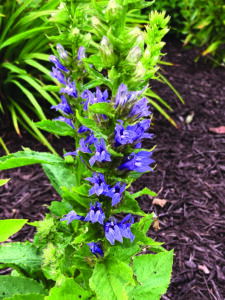
Great Blue Lobelia is a native wildflower that thrives in rich and moist to wet soils in full sun to partial shade gardens. (Photo by Ginny Rosenkranz)
Lobelia siphilitica or the Great Blue Lobelia is a native wildflower that thrives in rich and moist to wet soils in full sun to partial shade gardens.
The sunnier the garden, the more moisture they will need.
The plants grow in clumps about 2-3 feet tall and 1 to 1 1/2 feet wide with green lance-shaped leaves that have a toothed margin.
The leaves are spaced in an alternate fashion on the dense thick stems that, when mature enough, will also hold the lovely flowers that rise above the foliage.
The flowers form where the leaves stop and begin to bloom from the bottom of the flower stalk to the top.
The bright blue bell-shaped flowers have a tubular base with two lobes on the upper lip of the tube and three lobes on the lower lip.
These lobes provide a wonderful resting place for many of the pollinators that visit the Great Blue Lobelia including hummingbirds, colorful butterflies.
These beautiful flowers can bloom from July to October, filling the late summer garden with color from both the flowers and the lovely pollinators.
They fit into perennial borders or wild native gardens.
Because they like the soils to be moist, the Great Blue Lobelia will thrive near natural ponds and along a streambed.
The plants will go to seed in the late fall and will help create a small, non-invasive colony that will continue to offer color in the late summer into early fall.
Although it is said to be both rabbit and deer resistant, it depends on how large the deer and rabbit populations are.
(Editor’s Note: Ginny Rosenkranz is a commercial horticulture specialist with the University of Maryland Extension.)



